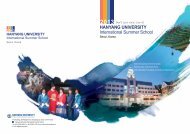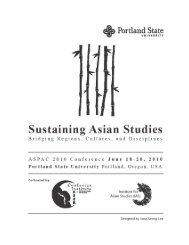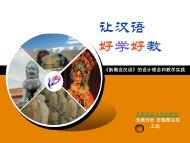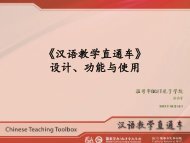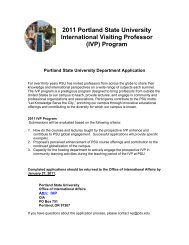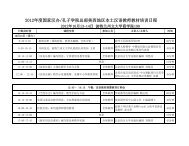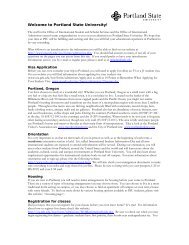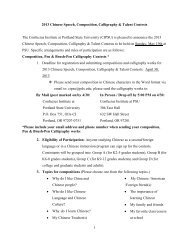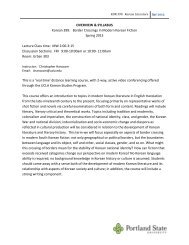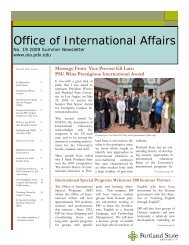ABSTRACTS - oia - Portland State University
ABSTRACTS - oia - Portland State University
ABSTRACTS - oia - Portland State University
You also want an ePaper? Increase the reach of your titles
YUMPU automatically turns print PDFs into web optimized ePapers that Google loves.
ASPAC Conference 2010<br />
June 18 – 20, 2010 | <strong>Portland</strong>, OR<br />
First it describes colonizer Japanese male and female’s self-fashioning as a middle class people in<br />
1930’s colonial Taiwan. Secondly, it describes communication with the dead, in other words bun-yuu (partage)<br />
of violent memories and death using the techniques of magical realism. The dead in this novel include both<br />
Japanese and indigenous Taiwanese people, the Sedrq in the “Musya” incident of 1930 and the Japanese<br />
female heroine Micha’s child as well as her niece, Lili’s child, and also Tsushima’s lost child.<br />
Third, this report considers how Tsushima’s perception of colonial Taiwan and the effect of the bunyuu<br />
of memory can be related to recent historical fruit. Nakamura Masau’s Captivity: Historical Anthropology on<br />
Subjective Nature and Social Power in Colonial Taiwan (2009, Ha-besuto) describes the colonial expansion of<br />
Japanese capital and the Emperor system of the modern state in relation to Japan and the indigenous<br />
Taiwanese peoples. The recent works of Tsushima (born in 1947) and Nakamura (born in 1944) who are of<br />
the same generation, overlap at the point of reflexive description of modern Japan’s behavior in relation to<br />
colonial Taiwan, especially its indigenous peoples. This report will investigate both memory and historical<br />
recognition from the point of how to take responsibility for colonial rule.<br />
~ ~ ~ ~ ~ ~ ~ ~ ~ ~<br />
Pramila Neupane<br />
Globalization and Education in Asia: A Comparison between Success and Failure<br />
Link between education and globalization is one of the major subjects of interest in the contemporary<br />
discourse on international development. Increasing global interaction and interdependence has expanded<br />
opportunities for those countries in Asia with better levels of education but has made progress more difficult<br />
for countries with low levels of education. Thus, what are the relationships between globalization and<br />
education in the region and to how important is investment in human resources for gaining more benefits<br />
from the increasing trend of globalization and ultimately for the development of a country? To answer these<br />
questions, this paper compares the education, globalization, income and health indicators of successful and<br />
unsuccessful countries in terms of per capita income growth over the period of 1970 to 2006. The study finds<br />
that countries with high levels of education, savings and good socioeconomic policies have attracted foreign<br />
direct investment and advanced technology, and have achieved rapid export growth and other aspects of<br />
globalization. For example, South Korea, Malaysia, Thailand, and China represent such success stories. On the<br />
other hand, countries with low levels of education, such as Bangladesh, Nepal, Pakistan and Papua New<br />
Guinea have found it more difficult to achieve progress. They have experienced very slow growth in per<br />
capita income and have not been able to effectively integrate with the global economy and society. Rather,<br />
globalization has made it more difficult to secure investment in education in these countries, because<br />
government expenditures in the social sector have been severely reduced to adjust to the negative<br />
consequences of globalization. Consequently, the development gap has been widening in the region.<br />
Successful countries have a good spread of education that leads to high growth and more resources for<br />
further educational development, whereas failing countries have poor human resources that lead to very low<br />
growth and limit their capacity to build up their educational systems. Thus, how to secure the necessary<br />
investment in the education sector in such countries is the urgent issue for further research.<br />
~ ~ ~ ~ ~ ~ ~ ~ ~ ~<br />
Jeffrey Newmark<br />
Confucian Diplomacy in Early Modern Japan and Korea: Amenomori Hōshū (1668–1755)<br />
In the narrative of Tokugawa era Confucianism, Amenomori Hōshū represents an aberration of sorts. Even<br />
after Ogyū Sorai’s (1666-1728) spearheaded the turn toward kogaku (ancient studies), Amenomori levied<br />
criticism on his contemporary by criticizing Sorai’s emphasis on philology over virtue. In contrast,<br />
Amenomori’s philosophy relied on the Song Confucian interpretation of the Confucian Classics and offered a<br />
series of didactic platitudes that at times inverted or simply restated the teachings of Han Yu (768-824) and<br />
Chu Hsi (1130-1200). Yet, Amenomori’s principal contribution to Edo Confucianism was not in the realm of<br />
thought, but rather in the diplomatic world. Amenomori Hōshū served as a quasi-diplomat for the Tokguawa<br />
Shogunate in the mid eighteenth century. While his predecessor in intellectual diplomacy, Arai Hakuseki<br />
27



